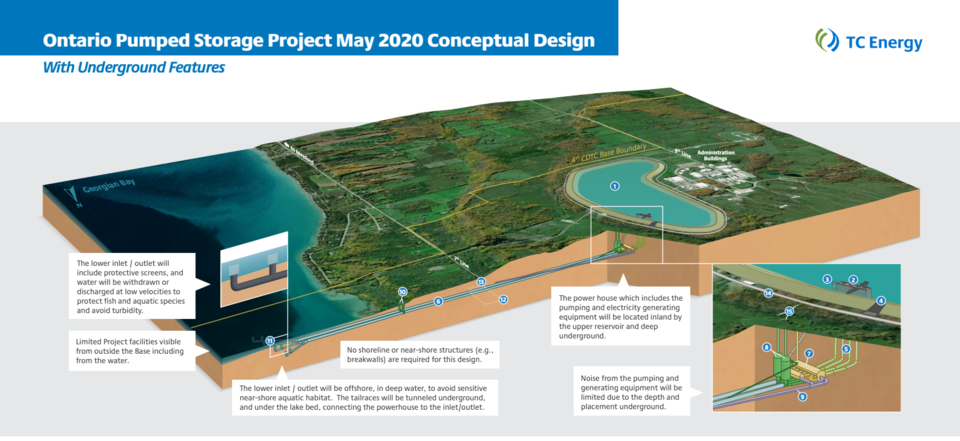The company proposing a hydroelectric pumped storage facility in Meaford recently purchased land in Wasaga Beach to use for hydro wires in case their project goes ahead.
TC Energy bought land off Shore Lane east of Constance Boulevard in Wasaga Beach.
According to a company spokesperson, Jennifer Link, the company is investigating an underwater transmission route for power lines from Meaford to their newly purchased land in Wasaga Beach. The lines would come out of the water in Wasaga and run underground to the Hydro One transformer station in Stayner, and the power would continue to flow from and to the Essa transformer station.
TC Energy hasn’t passed its first stage of approvals yet, as it is still waiting for an answer from the Department of National Defence on whether the federal government considers it feasible to build and operate a pumped storage facility on the 4th Canadian Division Land Training Centre military base (Meaford).
“Projects like our proposed pumped storage project require a significant amount of thoughtful planning,” stated Link. “Should the project proceed, we know it will require a connection to Ontario’s electricity grid, which is why we are starting to plan now.”
TC Energy, formerly TransCanada, announced a proposal in 2019 to build a hydroelectric pumped storage plant on the shore of Georgian Bay in Meaford.
The concept is to “store” power by filling and draining a water reservoir every day, so the company needed a site with the proper elevation and proximity to a shoreline.
The plan is to use pumps at night time, when electricity demand and pricing is low, to take water from Georgian Bay and fill a reservoir inland, about 150 metres above the water level.
TC Energy wants to build a reservoir adjacent to the military base's administration complex that would cover 375 acres in surface area and would be 20 metres deep. The reservoir would hold 20 million cubic metres of water.
The water would come from Georgian Bay via intake lines that run far offshore underwater and into the bay. The water intake/outlet would tunnel beneath the lakebed into deep water and the ends of the tunnels would be raised off the lakebed where they will suck water from the bay at night time and return it during the daytime.
The power house with the pumps and generating equipment will be contained in a building constructed underground, nearer to the reservoir. The pumps will use electricity to bring water from the bay to the reservoir at night time when power is at its cheapest.
During the day, when the demand for power is higher, the water will be released from the reservoir back into the bay using gravity. The movement of the water back to the bay will be harnessed to generate electricity.
It will take 11 hours to pump the water from the bay to the reservoir. The station will then generate power for eight hours as it returns the water to the bay. The power would be sold at a profit back to the provincial grid.
To get power to and from the grid, TC Energy will have to connect to the Essa transformer station with high voltage power lines.
Initially, the company was looking at two options for the power lines, one route underwater and one by land.
“We are proposing to proceed with lakebed cables,” said Link in an email. “Community feedback was really the driver for this decision – it was clear that this was the preferred option to overland.”
The transmission route would be part of the environmental assessment process required for the project, “should the project advance to that stage,” according to Link.
Area residents have joined forces to lobby tenacious opposition against the plan and formed a group called Save Georgian Bay. The group’s objective has been to inform the public about the project and also raise concerns about the design and the concept.
An online petition started by Save Georgian Bay calls on the House of Commons to deny the project. The group argues it is harmful to the “pristine” environment of Georgian Bay and the Niagara Escarpment; they say it will kill fish and destroy fish habitat.
There have been other concerns raised by the group such as the safety of those living below the proposed reservoir site, and the ethics of using expropriated land for a for-profit venture. The base was created by expropriating private lands from both Indigenous and non-indigenous people in the 1940s.
The project is expected to cost in the range of $3 - $4 billion to complete and could be operational by 2027.
Link confirmed the Meaford proposal is still “very early” in its development. Though the Department of National Defence indicated it would be giving an answer on the question of feasibility with the military operations in 2020, no answer has been forthcoming yet.
Meanwhile, TC Energy is working on other feasibility studies including preliminary aquatic, engineering and environmental terrestrial studies.
Even with a go-ahead from the DND (which hasn’t been granted yet) the project will still require other provincial and federal approvals along the way before shovels can go in the ground.
For more on the TC Energy proposal and public opposition, click here.

